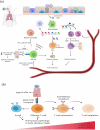Immune dysregulation and system pathology in COVID-19
- PMID: 33757410
- PMCID: PMC7993139
- DOI: 10.1080/21505594.2021.1898790
Immune dysregulation and system pathology in COVID-19
Abstract
The coronavirus disease 19 (COVID-19) caused by the novel coronavirus known as SARS-CoV-2 has caused a global public health crisis. As of 7 January 2021, 87,640,402 confirmed cases and 1,891,692 mortalities have been reported worldwide. Studies focusing on the epidemiological and clinical characteristics of COVID-19 patients have suggested a dysregulated immune response characterized by lymphopenia and cytokine storm in these patients. The exaggerated immune response induced by the cytokine storm causes septic shock, acute respiratory distress syndrome (ARDS), and/or multiple organs failure, which increases the fatality rate of patients with SARS-CoV-2 infection. Herein, we review the recent research progress on epidemiology, clinical features, and system pathology in COVID-19. Moreover, we summarized the recent therapeutic strategies, which are either approved, under clinical trial, and/or under investigation by the local or global health authorities. We assume that treatments should focus on the use of antiviral drugs in combination with immunomodulators as well as treatment of the underlying comorbidities.
Keywords: SARS-COV-2; ards and multiple organs failure; covid-19; cytokine release syndrome; lymphopenia; pathogenesis.
Conflict of interest statement
The authors disclose no competing interests.
Figures



References
-
- Sarzi-Puttini P, Giorgi V, Sirotti S, et al. COVID-19, cytokines and immunosuppression: what can we learn from severe acute respiratory syndrome? Clin Exp Rheumatol. 2020;38(2):337–342. - PubMed
-
- Song P, Karako T.. COVID-19: Real-time dissemination of scientific information to fight a public health emergency of international concern. Biosci Trends. 2020;14(1):1–2. - PubMed
Publication types
MeSH terms
Substances
LinkOut - more resources
Full Text Sources
Other Literature Sources
Medical
Research Materials
Miscellaneous
